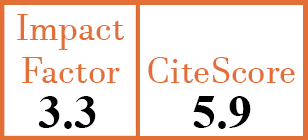Full Papers
Serum cathepsin S and cystatin C: relationship to subclinical carotid atherosclerosis in rheumatoid arthritis
B. Tejera-Segura1, A.M. De vera-González2, R. López-Mejías3, M.A. González-Gay4, I. Ferraz-Amaro5
- Division of Rheumatology, Hospital Universitario de Canarias, Tenerife, Spain.
- Central Laboratory Division, Hospital Universitario de Canarias, Tenerife, Spain.
- Epidemiology, Genetics and Atherosclerosis Research Group on Systemic Inflammatory Diseases, Division of Rheumatology, IDIVAL, Santander, Spain.
- Division of Rheumatology, Hospital Universitario Marqués de Valdecilla, IDIVAL, Santander, Spain; and University of the Witwatersrand, Johannesburg, South Africa.
- Division of Rheumatology, Hospital Universitario de Canarias, Tenerife, Spain. iferrazamaro@hotmail.com
CER8735
2016 Vol.34, N°2
PI 0230, PF 0235
Full Papers
Free to view
(click on article PDF icon to read the article)
PMID: 26941186 [PubMed]
Received: 30/06/2015
Accepted : 07/10/2015
In Press: 26/02/2016
Published: 13/04/2016
Abstract
OBJECTIVES:
To assess whether serum cathepsin S and cystatin C, two novel markers of cardiovascular disease risk, are associated with subclinical carotid atherosclerosis in patients with rheumatoid arthritis (RA).
METHODS:
Serum cystatin C and cathepsin S levels, carotid intima-media thickness (cIMT) and carotid plaques were assessed in a cross-sectional study involving 178 RA patients.
RESULTS:
An association between disease activity scores with higher levels of cystatin C, but not with cathepsin S, was found. Cystatin C levels were also associated with cIMT in the patient subgroup included in the higher quartile of Cimt (OR 1.31, 95%CI [1.00-1.72], p=0.04) after adjusting for traditional cardiovascular risk factors, age and sex. An association between serum cystatin C levels and carotid plaques was also found in the univariate analysis (OR 1.37, 95%CI [1.06-1.76], p=0.02). However, this significant association was lost after adjusting for traditional cardiovascular risk factors and age. Cathepsin S was not associated with cIMT or carotid plaques.
CONCLUSIONS:
High cystatin C serum levels identify a subgroup of RA patients with a high risk of subclinical atherosclerotic disease.


